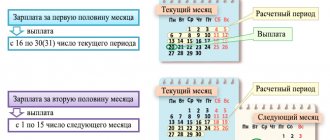From April 1, 2021 (and this is not a joke), the order of the Ministry of Health and Social Development of Russia dated April 12, 2011 N 302n
, according to which workers underwent medical examinations.
Instead, the following will take effect:
— Order of the Ministry of Health of Russia dated January 28, 2021 N 29n “On approval of the Procedure for conducting mandatory preliminary and periodic medical examinations of workers”;
— joint order of the Ministry of Labor of Russia and the Ministry of Health of Russia dated December 31, 2020 N 988н/1420н “On approval of the list of harmful and (or) hazardous production factors and work, during which mandatory preliminary medical examinations are carried out upon entry to work and periodic medical examinations.”
Despite the fact that the procedure for medical examinations has already been adjusted in 2021, the 2021 document contains even more innovations.
Regulatory framework for medical examinations
The regulatory framework on the issue of undergoing medical examinations is Article 213 of the Labor Code of the Russian Federation, which approved the need for certain categories of workers to undergo them, and Order 302n, which summarized the conditions and procedure for their implementation. This Order is a document consisting of three Appendices:
- List of VOPFs, in the presence of which you should undergo medical examinations (hereinafter referred to as Appendix No. 1)
- List of works during which medical examinations are carried out (hereinafter referred to as Appendix No. 2)
- The procedure for conducting medical examinations (hereinafter referred to as Appendix No. 3)
In 2019-first half of 2021. Significant changes were made to Order 302n three times:
- by order of the Russian Ministry of Health of December 13, 2021 N 1032n
- by joint order of the Ministry of Labor of Russia and the Ministry of Health of Russia dated April 3, 2021 N 187n/268n
- by order of the Russian Ministry of Health of May 18, 2021 N 455n
What's new in the medical examination rules in 2021?
When updating Order No. 302n (it was made by Order of the Ministry of Health of Russia dated December 13, 2019 No. 1032n), changes were made to 3 appendices to it:
- No. 1, which is a list of harmful and dangerous factors, the presence of which requires mandatory medical examinations (both preliminary and periodic);
- No. 2, consisting of a list of works, participation in which requires the establishment of control over the health of performers;
- No. 3, which describes the rules for conducting medical examinations of both types and a list of indications that prevent access to work.
The amendments in Appendices No. 1 and No. 2 are purely technical, caused by clarification of the wording and adjustment of the numbers of paragraphs of the rules to which these appendices refer. The most significant changes for both applications were the exclusion from them of the texts of notes listing the types of medical procedures performed during examinations.
The main scope of amendments is related to Appendix No. 3.
Among them there are updates of a technical nature (replacing definitions with more modern ones, clarifying wording, referring to updated or supplementary regulations, adjusting the changed numbering of points), but the predominant changes are those introducing new provisions into the medical examination procedure.
Changes to Appendix No. 1 of Order 302n
One of the main questions when compiling a contingent of persons who are subject to medical examinations is “Is it necessary to undergo medical examinations if there are VOPFs at the workplace?” This was especially true for workers who work on personal computers (PCs).
At the end of 2021, the following changes were made to paragraph 3.2.2.4 of Appendix No. 1 of Order 302n:
Old version:
electromagnetic field of a broadband frequency spectrum from a PC (work on reading, entering information, work in dialogue mode for a total of at least 50% of the working time)
A new version:
electromagnetic field of a broadband frequency spectrum (5Hz-2kHz, 2kHz-400kHz) (if the maximum permissible level is exceeded)
From the new version it is clear that medical examinations using electromagnetic fields from a PC in a specified frequency spectrum are carried out only when the maximum permissible level is exceeded.
It is worth noting that this change is of a formal nature, because 2 footnote to Appendix No. 1 of Order 302n it has already been determined that the list of harmful factors includes factors that, according to the level of their impact, are classified as harmful and (or) dangerous classes,
in accordance with current regulatory legal acts, which is the Federal Law of December 28, 2013 No. 426-FZ “On special assessment of working conditions.”
But how to conduct studies of electromagnetic fields from PCs as part of a special assessment, taking into account footnote 5 to the Classifier of harmful and (or) dangerous production factors remains a mystery. Perhaps this is why the frequency ranges were clarified and the connection to the PC was excluded.
Question-answer (answers to the most frequently asked questions regarding help from the forums)
My activities are in no way connected with the performance of responsible work. Can I not undergo examination by a narcologist and psychotherapist? As far as I know, previously this was only relevant for people involved in steeplejack work.
According to the new Order from the Ministry of Health (dated 2011), you are required to undergo examination by a narcologist and psychotherapist. Without this, you simply will not be issued a certificate.
Is the need for a medical examination based on OPF, VPF, or on the class of working conditions? Is a medical examination performed if a factor is present?
You need to carefully read the list of dangerous/harmful factors that are listed in Appendix No. 2. They are present either according to the results of certification, or they must be based on other data.
What if a person was hired before 2011 and did not undergo a medical examination? The fact is that now the company’s plans include organizing labor protection. Should I only send my employees for periodic testing? Is it possible to send them to pre-screening with new employees?
This is not prohibited by law. You can act at your own discretion, depending on the situation.
Is there a high probability of controversial issues arising after a preventive examination?
Yes, this is quite possible. Typically, such situations happen when applying for a job, when a person, fearing that the doctor will write something “wrong” in the application, hides his diagnosis. Over time, this leads to an exacerbation, and then to the development of an “occupational” disease. In this case, the clinic is obliged to include other doctors in the commission. After an additional examination, a new conclusion is drawn up. If the need arises, the employee is additionally sent to the occupational pathology center.
Changes in the composition of mandatory procedures and analyzes
In the new edition of Order 302n, footnote 3 to Appendix No. 1 and footnote 1 to Appendix No. 2 are excluded. They determined the range of mandatory procedures and tests during preliminary and periodic examinations of all subjects. Now, for this purpose, a separate paragraph 291 has been allocated in Appendix No. 3 and the range of mandatory procedures and analyzes has been significantly expanded.
When undergoing a medical examination, employees are now questioned to collect anamnesis, identify family history, complaints, and symptoms characteristic of certain diseases. Additionally, risk factors that increase the likelihood of developing chronic non-communicable diseases are identified. Among other things, body mass index is calculated based on measurements of height, body weight and waist circumference.
As before, a clinical analysis of blood and urine is carried out, the level of total cholesterol and glucose is determined, as well as fluorography or radiography of the lungs in two projections (direct and right lateral). All women are examined by an obstetrician-gynecologist with bacteriological and cytological examinations, and women over the age of 40 undergo mammography in two projections. Previously, this study was carried out once every 2 years, now - at every medical examination.
New types of research have also emerged for workers of different ages. For example, from the age of 18 it is necessary to measure blood pressure in the peripheral arteries, from 18 to 40 years the relative cardiovascular risk is determined, and at the age of over 40 years - the absolute cardiovascular risk. From age 40, intraocular pressure measurement is also required. The expansion of mandatory procedures was primarily aimed at obtaining a clearer picture of the health status of workers of different ages. But there is also a downside - additional financial costs for the employer due to the expansion of the research field.
What's new in the procedure for conducting periodic medical examinations in 2017-2018
In accordance with the order of the Ministry of Health of Russia dated December 5, 2014 No. 801n, which entered into force on February 16, 2015, changes were made to the order of the Ministry of Health and Social Development of Russia dated April 12, 2011 No. 302n, which introduced at the legislative level in terms of periodic medical examinations:
- new medical contraindications related to hearing loss for allowing an employee to work;
- new hazardous production factors associated with noise;
- classification of degrees of hearing loss for workers exposed to occupational noise.
Read about hazardous factors at work in our article “Dangerous and harmful production factors (list)” .
Thus, to the harmful physical production factors in the form of general vibration (clause 3.4.2 of Order No. 302n), another justification for regular medical examination has been added in the form of persistent hearing impairment of various etiologies, lasting over 3 months, with the exception of cases of complete hearing loss. The frequency of medical examinations of employees in this case is once every 2 years.
Once a year, as well as upon hiring, employees who work with industrial equipment that is a source of noise must be checked by doctors (clause 3.5 of Order No. 302n).
Persistent (over 3 months) hearing impairment was added to additional medical contraindications for work that requires periodic medical examinations (Appendix 2 to Order No. 302n):
- for climbing workers (clause 1);
- personnel servicing powerful electrical installations over 42 V AC and 110 V DC (clause 2);
- workers who are employed in areas remote from the nearest medical care (clause 4);
- employees working directly on equipment with open moving mechanisms (clause 10);
- employees working in gas masks (clause 13);
- motorcycle drivers - with complete deafness in one ear (clause 27.1).
In 2021, by order of 02/06/2018, the Ministry of Labor of Russia No. 62n and the Ministry of Health of Russia No. 49n amended the wording of one of the paragraphs of Appendix 2 to the order of the Ministry of Health and Social Development No. 302n:
| Clause 20 of Appendix 2 | Previous edition | Current edition |
| Work in pre-school educational organizations, children's homes, organizations for orphans and children left without parental care (persons in their place), boarding educational organizations, recreational educational organizations, including sanatorium type, children's sanatoriums, year-round holiday camps, as well as social shelters and nursing homes | Work in pre-school educational organizations, children's homes, organizations for orphans and children left without parental care (persons in their place), boarding educational organizations, recreational educational organizations, including sanatorium type, children's sanatoriums, year-round holiday camps, as well as social service organizations providing social services in a stationary form of social service, semi-stationary form of social service, in the form of social service at home |
Simplifying the procedure for undergoing medical examinations
In accordance with paragraph 61 of Appendix No. 3 of Order 302n, when conducting preliminary or periodic inspections, the following may be taken into account:
- Results of previously conducted preliminary or periodic inspections
- Medical examination results
- Other medical examinations confirmed by medical documents
The most important thing is that the results are no later than one year and that the employee has no symptoms of diseases indicating the presence of medical indications for undergoing a medical examination. Additionally, organizations conducting preliminary or periodic examinations may request from the medical organization at the employee’s place of residence or attachment all the necessary information to clarify the diagnosis.
Definitely, this change will have a positive impact on reducing the employer’s costs when undergoing medical examinations, especially in organizations with a high staff turnover or the presence of part-time employees.
Let's sum it up
- Since 2021, Order No. 302n of the Ministry of Health and Social Development of Russia has been updated, containing a list of harmful (dangerous) working conditions and rules for conducting medical examinations (preliminary and periodic). Non-technical amendments arose in Appendix No. 3, dedicated to medical examinations.
- The essence of the amendments boiled down to the emergence of requirements for a more in-depth collection of information about the state of health of the person being examined, the introduction of the opportunity to regularly interact with the medical institution observing him at the place of residence, and transfer examination data to the Social Insurance Fund.
Documents for medical examination
The composition of the documents that must be submitted by an employee to a medical organization when undergoing a medical examination has changed. Now, in addition to the previously usual referral, passport (or other identification document) and psychiatric examination (for some categories of workers), SNILS has been added.
To simplify the procedure for undergoing a medical examination, an employee entering work can provide an extract from the medical record at the place of residence or attachment with the results of the medical examination.
Secondly, the procedure for sending for a medical examination has been adjusted
The employer must now approve not only lists of already working employees, but also a list of people applying for work who are subject to preliminary examinations
. These are not lists of names; they must contain the name of the employee’s profession (position) according to the staffing table and the names of harmful production factors and work.
When sending for a medical examination, you will now need to indicate your health insurance policy number.
compulsory and (or) voluntary health insurance.
Referrals are allowed to be submitted electronically
using electronic signatures of the employer and the person applying for work. Accounting of issued directions can also be organized electronically.
Deadlines for medical examinations
As before, medical examinations must be carried out no less frequently than the periods specified in Appendix No. 1 and 2 to Order No. 302n. However, now, in accordance with changes to paragraph 16 of Appendix No. 3, the Employer can postpone the medical examination for a period of no more than 6 months if a high alert or emergency situation is introduced in accordance with Federal Law of December 21, 1994 N 68-FZ “ On the protection of the population and territories from natural and man-made emergencies.”
This change came into force on June 2, 2020 and was quite expected due to the spread of coronavirus infection (COVID-19) and the self-isolation regime introduced in the Russian Federation.
Periodic examinations at occupational pathology centers
Some categories of workers must undergo periodic medical examinations at occupational pathology centers (hereinafter referred to as centers). Let me remind you that these centers deal with issues related to protecting the health of workers and medical and social security for victims of industrial accidents and occupational diseases. In this connection, paragraph 37 of Appendix No. 3 to Order 302n determined the categories of workers who are required to undergo examinations at occupational pathology centers, their frequency and other requirements.
In the old version of Order 302n, this paragraph defined only general requirements for employees and the frequency of inspection. In the new one, some features have been additionally adjusted. For example, in the regions of the Far North and equivalent areas, as well as in the absence of an occupational pathology center in the locality in which the work is carried out, periodic examinations of workers with 5 years of work experience or more can be carried out not in a hospital setting, using mobile medical complexes.
But before this, workers must undergo appropriate diagnostic tests in medical organizations. And after conducting a periodic examination in a “mobile” center, the employee presents an extract from the medical record, which reflects the conclusions of medical specialists, research results, as well as conclusions based on the results of a preliminary or periodic examination for previous years of work in harmful and (or) dangerous working conditions. At the same time, during the year of the “mobile” examination, a periodic examination in another medical organization is not required.
Additionally, upon written request and if the employee agrees, the results of a periodic examination by the occupational pathology center are transferred to the Social Insurance Fund.
The changes made may solve problems associated with the peculiarities of undergoing medical examinations of certain categories of workers, and may also make it possible to reduce some financial costs associated with employee travel to inpatient occupational pathology centers.
However, there is another side - where to get “mobile” occupational pathology centers and at whose expense they will be “organized” in those very regions of the Far North.
Fourthly, the scope of medical examination has been adjusted
A mandatory examination by a neurologist has been introduced for all employees.
When collecting anamnesis from all workers, complaints and symptoms characteristic of dorsopathies
.
When conducting periodic inspections of workers in contact with:
- with chemicals that can cause allergic diseases, a dermatovenerologist and an otolaryngologist are additionally involved in the mandatory scope of examination;
— with aerosols of predominantly fibrogenic action, in addition to the mandatory scope of examination, digital radiography of the lungs in two projections is additionally performed;
- substances hazardous to human reproductive health, a surgeon is additionally involved in the mandatory scope of examination;
— carcinogenic substances, biological and physical factors additionally involve a dermatovenerologist and an otolaryngologist in the mandatory scope of examination, and digital radiography of the lungs is carried out in two projections.
Results of medical examinations
In accordance with the new edition of paragraph 46 of Appendix No. 3 of Order 302n, upon completion of the examination, medical organizations must perform the following actions:
- Provide the employee with an extract from the medical record with the conclusions of medical specialists, research results, the final conclusion, as well as recommendations for the prevention of identified diseases, including occupational ones, and, if there are medical indications, for further observation, treatment and medical rehabilitation
- Send a copy of the extract to the medical organizations at the employee’s place of residence or attachment, subject to the employee’s written consent
Summing up
With the amendments to Order 302n having entered into force, I would like to note the possibility of reducing the Employer’s financial costs by using the results of medical examinations that were carried out previously. Not least important was the expansion of the range of mandatory tests and procedures, as well as the possibility of transferring examination results to the medical organization at the place of attachment, which will provide a more complete picture of the employee’s health status. The employer must review the internal documents of the organization,, if necessary, make adjustments to the contingent of people undergoing medical examinations, and also work out the possibility of optimizing costs at their enterprise.
At the moment, the “new” 302n Order with the following changes is being considered on the Federal Portal of Draft Regulatory Legal Acts:
- There is no indication of the frequency of medical examinations
- There are no indications on the nomenclature of medical specialists, types of laboratory tests and additional medical contraindications
- Medical examinations according to the list of production factors are carried out (with some exceptions) depending on the established KUT
- Added indicators on the intensity of the labor process
- Decree personnel, medical personnel and teachers are excluded from the types of work for which it is necessary to undergo medical examinations
- The procedure for conducting medical examinations has been excluded, but the “old” procedure set out in Appendix No. 3 to Order No. 302n will remain in force
We can only believe that the division of the existing Order 302n into two documents will not be a formal procedure, but will bring some positive significant changes to the procedures for organizing and passing medical examinations.
Otherwise, this goes against the principles of the “regulatory guillotine” about removing the excessive administrative burden from entrepreneurship. Read the material in the source
Fifthly, new rules for recording the results of medical examinations
For example, in cases where it is difficult to assess the results of an examination, a person entering work due to an existing illness will now be issued a certificate indicating the need for additional medical examination
.
The employer is sent information about the issuance of such a certificate, and the person applying for work is considered to have not passed the preliminary examination.
An examination of professional suitability is carried out in such cases by a person applying for work independently within the framework of the state guarantee program for the provision of free medical care to citizens.
Conclusions based on the results of medical examinations are allowed to be issued in the form of an electronic document
, signed with an enhanced qualified electronic signature, through transmission over secure communication channels that exclude the possibility of unauthorized access to information of third parties, and in compliance with the requirements of the legislation of the Russian Federation on the protection of personal data.
Dear readers, if you liked the review, do not forget to like and subscribe to new articles and reviews, and share with colleagues!
For legal assistance, you can contact medical lawyer Vadim Sergeevich Berezinsky in the professional community Vkontakte https://vk.com/medicinskijyurist .








